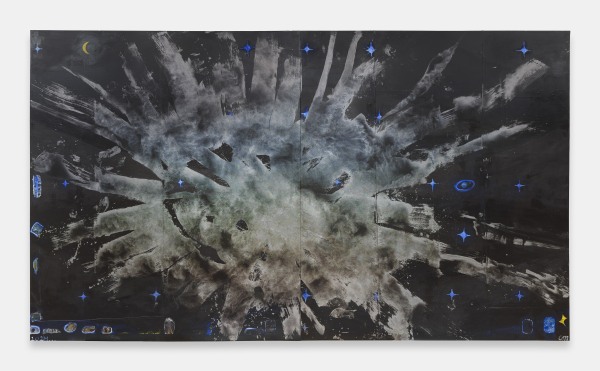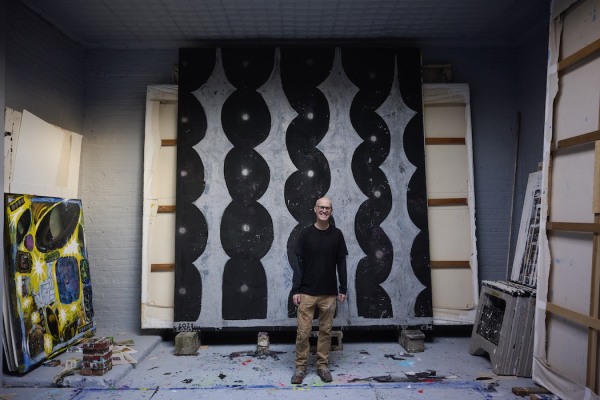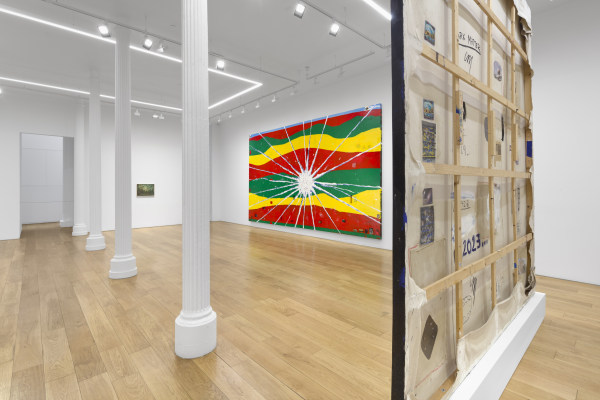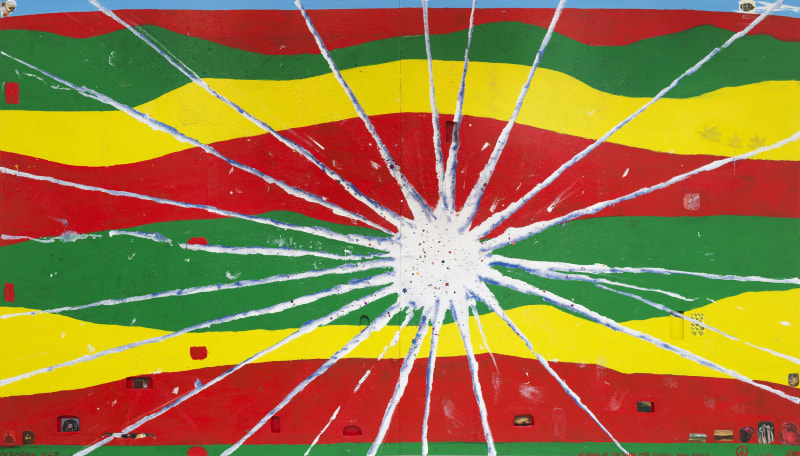Chris Martin: Speed of Light
-
Overview
Timothy Taylor is pleased to present Speed of Light, an exhibition of new and recent paintings by Chris Martin. The artist’s second solo show with the gallery and first at Timothy Taylor in New York, the exhibition features six atmospheric abstractions that revel in material discovery.
Martin has for nearly five decades invested in a painting practice that privileges process, directness, and an openness to experience. Bringing a vivid gestural freedom to a deep knowledge of the histories of abstraction and an omnivorous appetite for culture, he paints animated compositions that evoke cosmic phenomena, the landscape, and questions of scale. Elements of assemblage appear on Martin’s canvases—he is wide ranging in the vernacular materials he integrates into his paintings: glitter, images ripped from astrophysics books or pop culture magazines, bread, studio detritus, or aluminium foil. The resulting works are characterised by a playful tension between pictorial and actual space, as well as the prosaic and the sublime.
At Timothy Taylor, two diptychs of monumental size appear alongside two large paintings and a small work on a found painting; each of them is evidence of a process in which Martin mines and interweaves wide-reaching cultural, spiritual, and historical references in search of a state of transcendence. The present canvases are variously inspired by the landscape surrounding his studio in the Catskill Mountains, the Souls Grown Deep artists, and jazz music.
The diptych Staring Into The Sun 748 Russell Hill Road (2024) features a piercing white sunburst set against an abstracted pastoral landscape in Martin’s signature attenuated stripes of bold yellow, green, and red. A sliver of sky-blue lines the upper edge of the canvas, emphasising a distant horizon. Across the canvas, Martin has cut out small recesses, some of which contain collaged found images, including sunsets and mountain views, fragments of Rococo paintings, and a taxonomical image of frogs. Disposable solar eclipse glasses and leaves are assembled on the canvas, all of it loosely pointing to the nature of time and life’s cycles. Inscribed twice on the work’s lower left border is “OCTOBER TAZ.” The acronym TAZ (Temporary Autonomous Zone) has appeared in many of Martin’s works, signifying for the artist anything “from a commune that lasts for years, a few hours or a month working on a painting, or a day in the landscape.”
In another new diptych titled Speed of Light (2024), a silvery bloom expands against a black ground. Rendered in explosive gestural marks, the form calls to mind vapours and craters, churning accumulations of gas and matter. Radiant blue and yellow symbols of stars, crescents, and diamonds surround this central form, as do small islands of clipped found images, one of a dark highway. At once improvisatory and balanced, the painting evokes a vast, unknowable frontier. In both diptychs, spectral footprints appear—traces of the artist’s presence and process.
Installed freestanding in the centre of the gallery is a canvas which features a richly textured black expanse punctuated by an almost regular pattern of stars. Washy layers of colour peek out from behind the black, suggesting deep unknowable space and the enigmatic activities therein. The work is positioned so that its verso is visible. The verso, like many of Martin’s canvases, is populated with ephemera—collaged texts and images, clippings from album covers—that informed Martin’s process as he created the painting. Throughout are circular forms, suggesting themes of unity, natural cycles, and infinity.
An accompanying heavily textured painting brims with materiality and varied approaches to mark-making. Undulating passages of silver glitter comingle with washes of acidic colour and clouds of vegetal green. The gestalt evokes a tidepool or shallow pond at night, a primordial soup; but a purifying blue form seeps in from the top left corner, suggesting transition.
The smallest work in the exhibition, Mushroom Cabin (2006–12)—for which Martin painted over a found painting—is a small landscape that pictures the faint silhouette of a cabin, its windows aglow with amber light. Surrounding the structure are ghostly fungal forms that reach up to a white psychedelic moon. Echoes of light loop around the composition, forming subtle pools on the ground.
Across these works, Martin meditates on the connections between the macro and the micro, organic and inorganic, knowledge and innocence, tradition and abandon.
Concurrent with our exhibition, Martin is included in the Brooklyn Museum’s inaugural edition of The Brooklyn Artists Exhibition (on view through January 26) on the occasion of the museum’s 200th anniversary. The artist is represented by Anton Kern Gallery in New York, David Kordansky Gallery in Los Angeles, and Timothy Taylor in London.
On the occasion of the exhibition, Martin will be in conversation with artist Peter Halley which will take place at the gallery on Wednesday 12 February at 6pm.
-
Works
-
 Chris MartinStaring Into The Sun 748 Russell Hill Road2024Acrylic, collage, sequins, and glitter on canvas135 x 236 in. (342.9 x 599.4 cm)
Chris MartinStaring Into The Sun 748 Russell Hill Road2024Acrylic, collage, sequins, and glitter on canvas135 x 236 in. (342.9 x 599.4 cm)
Each panel: 135 x 118 in. (342.9 x 299.7 cm) -
 Chris MartinDark Matter2024Oil, acrylic, collage, and glitter on canvas135 x 118 in. (342.9 x 299.7 cm)
Chris MartinDark Matter2024Oil, acrylic, collage, and glitter on canvas135 x 118 in. (342.9 x 299.7 cm) -
 Chris MartinSpeed of Light2024Acrylic, collage, and glitter on canvas135 x 236 in. (342.9 x 599.4 cm)
Chris MartinSpeed of Light2024Acrylic, collage, and glitter on canvas135 x 236 in. (342.9 x 599.4 cm)
Each panel: 135 x 118 in. (342.9 x 299.7 cm)
-
-
Installation Shots
-
Video
In Conversation:Chris Martin and Peter Halley
Chris Martin and Peter Halley discuss Martin’s exhibition, “Speed of Light,” at Timothy Taylor in New York—his second solo show with the gallery and first at Timothy Taylor in New York.
The pair reflect on their five-decade-long friendship in the New York art world, their work and life as painters, and share memorable teaching moments.
Chris Martin: Speed of Light
16 January — 22 February 2025
New York -
Event
-
Press
-

Chris Martin: Screen Time, Supernovas, and Ghost Pianos – Our Critics on What to See Now in New York
John Vincler, CULTURED, 19 February 2025 -

Chris Martin: An Arrival and Eternal Return of Painting
Phong Bui, The Brooklyn Rail, 5 February 2025 -

Chris Martin Takes on the Cosmos
Edward Waisnis, Whitehot Magazine, 25 January 2025 -

Chris Martin: Staring into the sun
Sharon Butler, Two Coats of Paint, 23 January 2025 -

Chris Martin: The Painter Whose Canvases Have Hidden Messages
Abstract Paintings Inspired by the Night Sky, on View in New YorkJameson Montgomery, T Magazine, 16 January 2025
-













